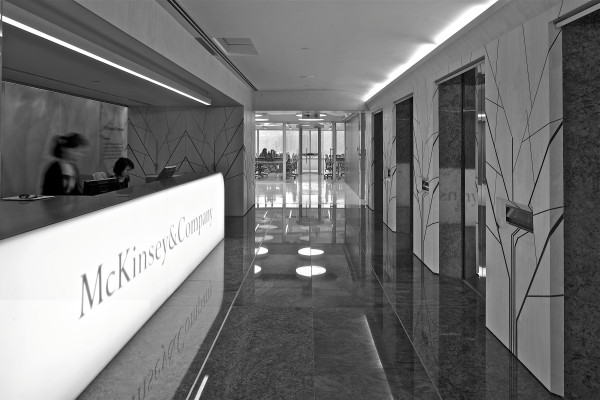Management consulting firms want to move into the creative process, and creative agencies want to move into management consulting. It seems that everyone wants to swim upstream towards the boardroom and consult on innovation, customer experience and design thinking. The widely held theory is that there are good margins in this type of work (and let’s be honest, it is sexy as hell). But what no one really talks about is that the high-end strategy work is actually important because it leads onto the multi-million dollar implementation projects that secretly feed the biggest global agencies

Over the years, I’ve worked in several of the grey areas between management consulting, advertising, and design thinking so I’ve seen some of these macro industry changes first hand. The toughest part of my career has always been finding the chink in a client’s armour that lets us get close enough to the boardroom to ask the really tough questions. It almost doesn’t matter what the starting point is for a project when your real goal is to get to the deeper issues inside a business. With all these shifting agency services, it’s hard for clients to know who to turn to these days for advice on big problems.
Great consulting always been about getting to the really gritty questions beneath the surface. Personally, I want to know why a company exists in the first place, who they care about, where they want to be in five years time and how they plan on putting a dent in the universe. Traditionally, management consultancies have held the monopoly on long term strategic planning. But that grip is rapidly crumbling. Therefore, when it comes to the agencies of the future, I’m interested in the question of:
Who will be the McKinsey of the next generation?
There are lots of interesting arguments about whether the best core skill-set for this type of work comes from technology, business or design. The global IT consultancies like IBM and even the accounting firms want to get into the innovation game as well.
But the bigger issue is that from a client’s perspective these skill-sets are looking more and more similar. I usually refer to this cross-functional type of work as innovation consulting because it reflects the modern mindsets of lean startup, agile software development and user-centred design.

The global management consulting firms like McKinsey, Bain and BCG have the scale to partner with giant clients to do big global “digital transformation” programmes and see those programmes through for the three to five years that they take to implement. Likewise, the giant advertising agencies (generally tucked inside WPP or Publicis Group) such as Grey, Ogilvy and BBDO are all big enough to throw their weight behind big multi-country, multi-year projects. These two sets of industry titans have their eyes on each other.
The giant management consultancies and global networked advertising agencies are having to fight hard to manoeuvre for these new revenue streams in design thinking and innovation consulting. I’ve noticed some common strategies that they are both adopting to compete on this new battlefield.
1. Growth Model: Acqui-hire
The latest way of getting into innovation consulting is to acquire a small agency doing the opposite of whatever it is that the acquirer does and bolting them onto the mothership. This called an “acqui-hire because it’s an acquisition for the purpose of hiring new staff.

If it’s handled well, an acquihire can be an awesome way of hitting the ground running with a strong team and good momentum. But more often than not, the shiny new team is soon gobbled up and lost inside the bureaucracy of the host organism.
- On the management consulting side: Deloitte have purchased and then absorbed several web design firms into Deloitte Digital (along with a more recent acquisition of Michael Porter’s Monitor Group) and Accenture have bought service design firm Fjord. Here in New Zealand, PWC acquired design thinking firm Optimal Usability to create the seed for what is now known as PWC Digital.
- On the advertising agency side: (from what I’ve heard), innovation agency The Social Partners became a productive part of (WPP owned) Grey pretty much from day one. Both WPP and Publicis/Omnicom have been on social media and digital agency buying sprees in the last five years or so with even big fish like AKQA being gobbled up by WPP. So far the the ad agencies seem to have been winning the acquisition game.
2. Growth Model: Lone Wolf
Another approach is to hire a new leader from outside and let them build an internal team themselves. This takes longer than an acquihire. The advantage is that the lone captain can gradually build a motley crew of rogues and pirates from both inside and outside the mothership who are just tough enough to keep the flame alive.

Hiring a lone wolf looks good in BusinessWeek, PR Week or Marketing Week because the agency can post a photo of their new Chief Innovation Officer standing in front of a brick wall wearing a black t-shirt and looking “innovative”. Appointing a heavy hitter looks good in front of clients and the press. By contrast, acquiring a small consultancy is messier to explain to clients and industry commentators.
- On the management consulting side: BCG, McKinsey and Bain have all been appointing senior partners to manage their digital innovation and design thinking capabilities but none have yet emerged as real heavy hitters with genuine thought leadership and client impact.
Inside the advertising agency networks: LBI have appointed an Organisational Design leader, Ogilvy have established a stealth innovation consulting division, Wolff Olins have been getting into Lean Branding, and BBH have the new Black Sheep Fund. My personal favourite of the lone wolves is Tom Goodwin who is the Head of Innovation at Zenith Media in New York. No one is quite sure what he actually does for a living but he’s very vocal on LinkedIn and he seems to attract the attention of a lot of in-house marketers who may well want to hire Zenith for media planning.
No matter whether you choose to buy a small firm or build your own innovation team, there several roadblocks to making it work in practice.
1. Growth Issue: Innovation is a team sport
The downside to acquiring a small firm or hiring a lone genius from outside is that one or two new people don’t magically create an innovation culture inside a global professional services business with long-established norms and structures. So suddenly the mothership’s HR team has to learn how to hire new people with new skills and professional backgrounds:
- The management consultancies are now trying to hire pure-play creative people. But they are finding it surprisingly hard to evaluate the creative skill set and to make use of those people once they’re part of the team. It turns out that consistently great creativity requires a supportive eco-system.
- Meanwhile, the advertising agencies are now hiring pure-play business analysts. But they’re finding it hard to evaluate the analytical skill sets and to make use of those new people once they’re hired. It turns out that great analytical thinking also requires a supportive eco-system.
It turns out that creativity really is a team sport, especially the art of solving client problems and helping encourage a client to become more innovative and user centred. When a project gets tough, you need a mix of different skills to get things done.
2. Growth Issue: Building an innovation consulting team of both specialists and generalists
Building an innovation consulting capability inside an agency requires a daunting mix of specialist skills. But it also requires a reasonable quota of generalists to play the role of the diplomat. Acting like a designer when the client is being too analytical and acting like a business person when the client is being too vague. These sorts of generalists bring balance. A good innovation team needs a healthy mix of specialists and generalists.
Specialists: Hacker, Hustler & Designer
The best way to understand how to build a team to advise clients on innovation is to look at how startups build an agile team with constrained resources. To bring a product to life in the startup world you need a hacker, a hustler and a designer. Because every product needs a mix of technology, business and design.
There is a ying and yang balance to innovation. A great design concept needs feasibility testing and a rigorous business model. A great business strategy needs emotional resonance from user-centred design. Both business and design also need technology to bring their ideas to life.
Generalists: Polymath Strategists
It’s rare, but there are individuals from within the fields of design, business and technology that also understand just enough of the other disciplines to be genuinely useful across every field. A polymath is someone who’s speciality is learning other people’s specialities quickly. Polymaths pride themselves on accelerating the time to minimum viable knowledge on a given topic.
The navy seals have a very special style of cross-disciplinary collaboration. Seal teams learn just enough of each other’s roles to be able to do their “buddy’s” job in an emergency. Not because you want your engineer acting as a medic all time, but because being forced to learn another person’s craft makes you appreciate it.
At the first design firm I worked in, I learned just enough Photoshop and InDesign to appreciate how hard it is to design with good taste. Likewise, in my in-house roles with various startups I’ve learned just enough coding to appreciate how much time it takes to built out a new feature.

A true polymath’s job history is almost always a mess. I’ve met polymaths called everything from “Creative Technologists” to “Information Architects”. The job title “Strategist” is a common place for these people to hide in plain sight because it covers a multitude of sins. There are plenty of polymath strategists hidden away inside ad agencies, design firms, market research firms and PR agencies.
These aren’t ‘jack of all trades’ generalists in the old tradition of mediocre MBAs hidden away inside global consulting firms. Instead, the modern polymath still needs a specialisation in one of the productive disciplines so that they can deliver immediate value when in front of the client. And they also need enough skills in the other disciplines to be a productive contributor, not just a commentator. The best strategists that I’ve met are confident in their craft but use it as a starting point for the real work of digging into the root causes of a client problem.
Solution: Innovating in-house
I’m a fan of the old-school management theorists like Tom Peters and Peter Drucker. Therefore, I’m bound to love the idea of building up a client’s own innovation capability. Best practise has always been to bring as much innovation expertise as possible inside the company. In 1996 Steelcase bought Ideo, BMW bought Designworks in 1997 and more recently Facebook gobbled up a design firm called Hot Studio, while Google have established their own innvoation and design thinking practise inside Google Ventures.

Clients are becoming more astute about how they buy strategy, design, and innovation services. The smartest clients are allowing all of their advisors to range beyond the old-school narrow project “briefs” and come back with integrated, creative and multi-channel solutions.
For in-house innovation to work, senior people inside the business need to be open to new ideas coming from anywhere (internal or external). The old way was to allowing grown-ups and “suits” (such as law firms, accounting firms and investment bankers) access to the boardroom. This is fast becoming an obsolete model.
You can’t firewall your advertising agency behind a 22 year old Junior Brand Manager, the agency needs access to the CEO to create great work. Likewise, you shouldn’t stop your design firm from asking to talk to the call centre staff about warranty claims. Great new ideas could come from all sorts of unexpected places.
Some clients are experimenting with internal venture capital models, internal innovation incubators and internal customer experience swat teams. These are powerful and transformative. But sometimes they do suffer from organisational capture and they get too stymied in corporate politics. A helping hand from the outside can make a real difference when taking on something new.
In-house capability is important to innovation but external advisors do still have an important role to play. The ability to brush your teeth every day doesn’t mean that you can get rid of your dentist entirely. I think there will always be a role for the dreamers, the crazy ones, the agencies just bold enough to think that they can change the world.
Note 1: The incumbent innovation agencies and design firms are already doing this type of work but have been caught out by the speed of change in terms of social media, digital innovation and lean thinking. They don’t seem to have a new story to tell (that would galvanise new multi-million dollar revenue streams).
Note 2: I’ve lumped all of the subsidiaries of the creative networks in with “advertising agencies”. WPP owned Hill + Knowlton (who work in PR) are as much a part of this trend as Starcom Mediavest (who are notionally a media buying agency, not an advertising agency).

Peter, what a great post!
As a ‘strategist’ I’m sat here now running through all the points you make!
The opportunities for really effective collaboration between the two sectors are very real.
Rich
Thanks for these great insights. I agree that companies need to embrace the smart-sourcing of innovation.
Thanks for the thoughtful article. I might add a couple of things to consider and get your view on?
First, the business model of management consulting firms is based on billable hours. This model is under immense pressure. Consulting requires annuity work if it is to be sustainable. Digital consulting with its ever changing technological, social and economic context requires constant innovation. The capacity for annuity work is there. However, why hire a whole firm when you can hire the guru in question from the firm much cheaper and get the guru in question, not just the guru at monthly meetings?
Second, you make very little mention of accounting within your article. Accounting is the language of business. If you cannot make accounting work towards the digital innovation in question, most organisations are doomed to failure – Clayton Christiansen’s ‘The Innovators Dilemma’. There is now considerable research to suggest that listed companies are becoming less innovative because, in part of accounting and the demand for short term profits.
Finally, to work in this space, which group do you think best illustrates the dictum ‘to eat their own dog food’ in other words, which provider group do you think have best harvested digital strategies in their own business model?
I would welcome your thoughts. Thanks again for a good discussion of the issues.
Cheers,
Mark
Great comments. I’ll respond to each one in turn:
– The issue of agency business models (annuities or otherwise) is covered in my prior article on the fight for social media consulting revenues among PR, Advertising and Design firms. They each have markedly different business models, which influence their approach to the craft. Ironically, in the current article (Management consultants vs Creative agencies) I think the business model for innovation consulting they they are pursuing is so similar that it’s not a material factor. Giant global consultancies all need giant multi-year projects to staff up.
– The issue of hiring the guru direct has always vexed the professional services. My first boss when I was a lawyer left the firm to do exactly that and I worked at the design firm Brian R Richards Limited during the (non trivial) transition to BRR Ltd. My friends at Monitor Group often had the “I want to speak to Michael Porter” problem. The best trick is to create a whole cast of mini-gurus in each functional craft and each industry vertical. These days it’s called “thought leadership”. McKinsey are the masters of this and it’s hard to point to any one guru in their ranks ahead of any other.
– The issue of commercialising innovation is so dear to my heart that this blog was called the “Economics of Innovation” for its first three years of life. In fact, ensuring a fit between business strategy and digital strategy is a large part of my day job. In this article, I deliberately left out the issue of how clients fund, recoup and account for innovation investment because both Management consultancies and Creative agencies should be equally able to advise on that issue. (Currently they can’t but that’s another story for another day.) As we say in in the game, “The ROI of social media is that you will still be in business in five years time.”
– Finally, on the issue of applying their own digital advice to themselves, both the Management consultancies and Creative agencies are woeful. No one has gotten this right and frankly it’s an embarrassment to the industry. Historically, I would have said Ideo or McKinsey but these days the best examples of living the message are coming from the Startup Foundries (like Betaworks and Makeshift) and the Digital Product Design firms (like Made by Many and Mint Digital).
This is one of the best reads I’ve come across in a while – very in tune with where the market is already headed with a view at an inevitable convergence.
As a strategist, I’m constantly looking at these cues for the implications on my own career planning. There are certainly bigger things ahead from a career development standpoint than siloed agency ‘experience’ building vs more traditional consultancy. Though, I’m still shaking that out.
What I’m seeing is that there isn’t one particular type of company (agency vs consultancy) better suited to innovation. But a danger of inviting everyone to the table is the inevitable “fat” of less useful resources (which, given agency histories, is likely to be tactical resources guised as “strategists”).
As you mentioned, the opportunities ahead will be seized by customer experience strategists with agility and integration skills.
Great post – I really like the hacker, hustler, designer analogy.
Every product does indeed need a mix of technology, business and design. Any one individual who thinks that they are so good at all three that they don’t need a team is pretty deluded.
Excellent piece. I started my digital firm in 1995 when organizations were just trying to figure out if the web was a “thing” or not. Fast forward now 19 years, and many of the same challenges still exist. The labor (or labour, as my friends across the pond would prefer) of work continues to butt up against organization unwilling to change. They are hell bent on making it a technology problem. Or a customer problem. Etc. Etc. But these are ALL people and organization challenges. As a result, I have FINALLY started an consulting practice to help organizations of all kinds develop the culture, skills, technology, structures, and measures to bring themselves back to life. We are not the Bains of the world. The end result of our work is an actual project, a new product launch, a new digital property, and new something that takes all the elements of success and molds them together into something the organization can see themselves attain on their own. This breaths confidence and life, and brings about the healthy mental attitude that change is actually possible. Too often, the consulting firm’s product is a PPT or three-ring binder. You have to put these new principles to work and create something new to have any sustaining power. Thanks for a great conversation!
Spot on.
Hi Peter,
Great post!
From your experience – is building a core competence the field of creative thinking a profitable move for a strategy consultancy in the long run?
It seems like a competitive field and the potential synergies might actually come at a high cost (hiring, upkeep and integration of the new structures, etc.)
Hi Peter, great article. I think you’re missing another group – the pure digital agencies who don’t fit into the management consultancy or ad agency grouping. I would put them over the ad agency in terms of competitive advatnage. Keen to hear what you think?
Best,
George
This is pretty much where we are at Ephlux Insights, bridging management consulting type practices in expanding the product life cycle while utilizing the manpower of Ephlux, our financial backer, in customer experience augmentation.
We design and implement CX game changing ideas that merge digital and offline experiences to create brand awareness, preference, resonance, recall and conversions. At present, we partner with BCG for the Ephlux CX Cloud and education projects in the MENA region. We also ally ourselves with various agencies in the UK and Canada for workflows in consumer goods and retail brand experiences.
This article hits home the exact space we’re in.
I am a student trying to get into a career path where I can pursue creativity and innovation in a business forum. Currently, however I feel the pathways provided by Universities are too set to traditional professions (Australian University), and as a result I have found myself trying my hand in Engineering, Architecture and Law (currently Engineering and Law student) to try and find both aspects of creativity as well as a stepping stone into business.
Is there any advice you can offer for a) The type of backgrounds these type of agencies look for in students, and b) How students in a more traditional university system can skill themselves for these types of diverse careers, which require skills across multiple disciplines.
I knew a partner from McKinsey who used to say to potential hires, “It doesn’t matter what you do, just be awesome at it.” So my advice would be to press on with the Engineering and Law until you start to figure out which one of the two you are better at and then apply all your creative energy to being amazing at it. Ideo and the other design firms hire people from every professional background, but getting in as a graduate is very hard so it’s worth building up some professional experience. Just keep your hand in the game by reading, going to events and being creative on the side. One of the best ways to get practice at this type of stuff is to find friends who have an idea or a startup and to help them out.
Hi Peter,
I am a recent graduate new to Digital Advertising world. I’ve found it restricting because we dont’t get a say in overall strategy even when we see an opportunity from live data feedback. Which is what propelled me to search the web for a Agency/Consultancy hybrid. This post echos my wish perfectly.
My question is, should I stick with Digital Advertising or move to traditional consulting firm to have a better chance of working for one of these Digital Innovation Consulting companies? I have realized that consulting still carries more weight on a resume. Do you think this will still hold true in the future if agencies are closer to the changes in technology?
Thanks for any advice you have.